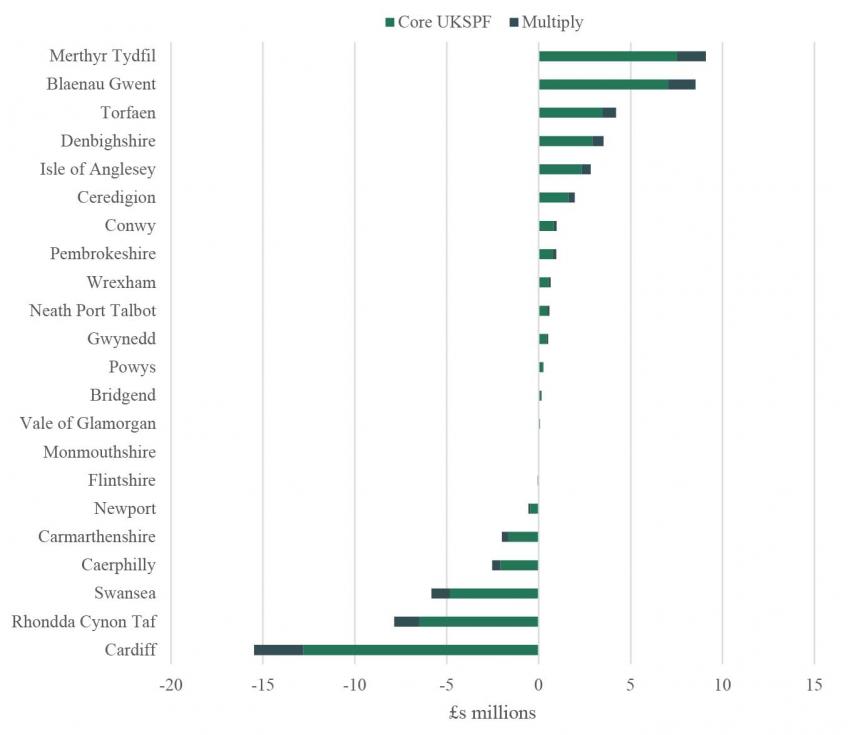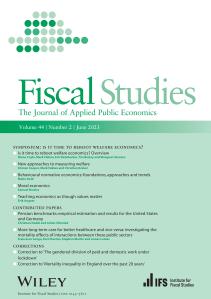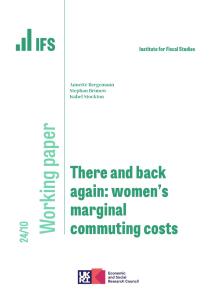In April, after multiple delays, the UK government finally announced how its replacement for EU regional development funding, the UK Shared Prosperity Fund (UKSPF), would be allocated across the country. Scotland, Northern Ireland and Wales, as well as each Local Economic Partnership (LEP) area of England, are set to receive the same share of funding as under the EU scheme. Within these nations and LEP areas, new formulas based on population and local economic circumstances will be used to allocate funding to individual councils.
As we said at the time, this was a missed opportunity to bring the funding allocations for the nations and regions of the UK properly up to date and to address some of the inequities in the old EU allocations. Unfortunately, in the case of Wales, the formula that the UK government proposes to allocate funding to individual councils also suffers from a significant flaw that penalises councils with large populations to the tune of millions of pounds.
How will UKSPF funding be allocated to Welsh councils?
The UK government proposes to allocate funding to individual councils on the basis of different formulas in the different nations. For Scotland and Wales this was after some (limited) consultation with the devolved governments of those nations.
The Welsh formula consists of three elements:
- 40% of funding is allocated according to the population of different council areas.
- 30% of funding is according to a composite index of economic ‘need’, also accounting for differences in population between council areas.
- 30% of funding is according to the levels of deprivation measured by the Welsh Indices of Multiple Deprivation (IMD), not accounting for differences in population between council areas.
For the latter two components, the area with the lowest need/deprivation receives zero funding. Other areas receive an amount which depends on how their level of need/deprivation compares to both the councils with the lowest and highest levels, and the Welsh national average.
The fact that the element based on deprivation takes no account of population differences is hard to fathom. It means that two areas with the same levels of deprivation receive the same total funding from this element, irrespective of how big their populations are. This contrasts with the approach taken for broader economic need, where two areas with the same levels of assessed need receive the same funding per person.
What impact will this approach have on different councils in Wales?
This matters because the population of different council areas in Wales varies substantially: the population of Cardiff was estimated to be over 6 times as large of that of Merthyr Tydfil as of mid-2020 (the population figures used elsewhere in the UKSPF allocation formulas). Rhondda Cynon Taf gets just 21% as much funding per person (£44) over the next three years from the deprivation element of the formula as Merthyr Tydfil (£208) despite being only a little bit less deprived, because its population is 4 times larger.
Figure 1 below shows how funding under the actual formula compares to what councils would receive if the deprivation element was adjusted for population in the same way as the broader economic need element is. Positive numbers show councils gaining from not accounting for population, and negative numbers councils losing.
Figure 1. Effect of not accounting for population in the deprivation element of UKSPF funding in Wales between 2022-23 and 2024-25 (£s millions)

Source: Author’s calculations.
For example, if the deprivation element accounted for population differences and all other elements of the formula remained the same, Cardiff, Rhondda Cynon Taf and Swansea would have received £15.5m, £7.9m and £5.8m more funding, respectively, over the next three years than under the formula actually being used. Merthyr Tydfil, Blaenau Gwent and Torfaen would have received £9.1m, £8.5m and £4.2m less funding, respectively, than they are actually set to receive. This flaw is therefore shifting tens of millions of pounds from Welsh councils with large populations to those with small populations.
Of course, we cannot say that a formula where the deprivation element accounted for population differences and all other elements remained the same as now would be the ‘right’ formula. There is no ‘right’ formula as people can reasonably differ on how targeted they think funding should be at the areas with the highest funding needs, and how to measure those needs. However, the deprivation element should clearly account for population: not doing so is indefensible. There is no good reason why two places with the same levels of deprivation should see funding per person vary just because their populations differ – which in principle in Wales could mean their funding per person could differ by up to 6 times.
How was this flawed formula chosen for Wales?
In its methodology note for the UKSPF allocations, the UK government says that this approach reflected three considerations:
- First, the fact that Welsh councils vary in population by less than English and Scottish councils.
- Second, ‘a commitment to co-produce and co-design with the Welsh Government’.
- Third, ‘the acknowledgement that stakeholders in Wales have a much better picture of the local situation than is known in Whitehall – therefore, this approach is recommended as it aligns with local feedback.’
It is true that there is a smaller difference between councils with the biggest and smallest population size for Wales than for England or Scotland – but a difference of over six times (for example, between Cardiff and Merthyr Tydfil) is still very substantial.
The second and third stated rationales led me in April to believe that the decision not to account for differences in population for the deprivation element of funding was taken in consultation with and led by the Welsh Government. I now understand that this was not the case.
How this odd decision was made is therefore unclear. Perhaps it reflects input from other (unidentified) local stakeholders. Or it could reflect a misunderstanding or miscommunication between the UK and Welsh governments. In turn, this may reflect the late and relatively limited engagement by the UK government with the Welsh and other devolved governments about how to allocate UKSPF funding.
Are the Welsh really that bad at maths? No
Another aspect of how the UKSPF is being allocated may also reflect a lack of meaningful engagement with the devolved governments: the approach to allocating ‘Multiply’ funding.
Multiply is a new numeracy programme that will be funded by a ring-fenced share of the UKSPF across the UK. Some will be retained by the UK government for a centrally managed online numeracy training platform. Most is allocated to councils to help improve numeracy in their areas, with the ultimate goal of enhancing job opportunities and boosting productivity.
Each nation, LEP area and council is set to receive the same share of Multiply funding as it will receive in core UKSPF funding. This means that Wales, which will receive a large share of UKSPF funding given the large share of funding it receives from EU schemes, will receive almost 7 times as much funding per person for Multiply than England.
Improving numeracy skills may have benefits in terms of employment, earnings and productivity. But while Wales does have lower levels of employment, earnings and productivity than England, it seems highly unlikely that spending seven times as much per person on numeracy skills is the best way to address this. Indeed, as of the early 2010s, levels of numeracy in Wales and England were almost identical (in both cases, poor).
Given UK government commitments to match previous EU levels of funding for each of the nations of the UK, the UK government could not just have reduced how much Multiply funding it gives Wales (this would have broken its pledge). But if it had engaged more with the Welsh Government at an earlier stage, it may have realised that it made sense to ring-fence a smaller proportion of total UKSPF funding to Multiply in Wales, allowing more to be spent on other types of economic development policies.
A control problem – and a solution?
There has been a control problem in the UK government’s handling of the design of the UKSPF. It failed to take back control of the overall approach to funding allocation by simply matching EU allocations for the devolved nations and LEP areas of England. But it’s arguably been too controlling on the details of the allocations, leading to some undesirable decisions in the case of Wales.
Given the UK government has not yet signed off on councils’ investment plans, it may be possible to address the particular issues highlighted in this observation. Politically though, it may be difficult to reduce funding for those council areas that have gained from the flawed formula used for Wales. Compensating those that have lost out while letting those who have gained keep their gains would cost £34 million over the next three years.









